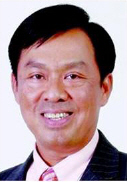EXECUTIVE Q&A: DRT BUILDING ON TWO DECADES OF SOLID WORK
SHAREINVESTOR

Satid: Technology provides the edge
Diamond Building Products Plc (DRT), formerly known as Diamond Roofing Tiles, has proved consistently successful and profitable during its 20 years of operation. The company attributes its success to a steady commitment to producing quality products that accurately reflect the needs of Thai and overseas consumers, together with strong management and human resources. Satid Sudbuntad, DRT's deputy managing director for sales and marketing, discusses the company's strategy and outlook.
BUSINESS:
What is DRT's business model?
Diamond Building Products's core business is to manufacture and distribute roofing tiles, sidings, fibre cement boards and other roofing accessories within Thailand under the trademark names Diamond Brand, Adamas and Jearanai.We also provide roof installation services to our customers.
Please provide a breakdown in revenue as per product type.
Currently 73% of our revenue comes from tiles,12% from siding and 7% from boards and ceilings, with the remainder from special products and services. Now when we look from the production line viewpoint, the breakdown is 60-40 between fibre cement and concreterelated products.
What are current utilisation rates? What is total production capacity today?Are there plans for expansion of production capacity?
We have 14 production lines that comprise nine fibre cement lines with a capacity of 435,000 tonnes and five concrete lines with a capacity of 245,000 tonnes, giving us a total of 680,000 tonnes. Our current average utilisation rate is 90%, but for our fibre cement production lines we are operating at full capacity; so we are investing 480 million baht in a 15th production line,or 10th fibre cement line, that will increase our capacity by 72,000 tonnes.Thus by the middle of next year we will have a total production of 752,000 tonnes.
What raw materials does DRT use?How does DRT manage the fluctuation in raw material prices?
The main raw material we use is cement, which accounts for 60% of our total cost, while our energy costs are lower than 5%. In Thailand there is a huge supply of cement, so we do not experience supply issues. And because we are able to purchase large volumes,we are able to negotiate with our three suppliers for discounts on a quarterly basis.
Who are DRT's major clients? Where does DRT sell most of its products?
We sell through two main channels:modern trade and retail customers. Our main modern trade customers are firms such as HomeWorks, Global House and Thai Watsadu, while for retail customers we sell through 3,000 selling agents that are focused in the centre of Thailand, as it is closest to our production facilities.In percentage terms,48% are retail construction material stores and 40%key accounts, with the remaining split between direct projects and modern trade.
INDUSTRY:
What are DRT's competitive advantages?
Our two key competitive advantages are our flexibility with our agents/sellers and the high quality of our products and their guarantees. We allow our network of agents to sell other brands'products in their stores while most competitors do not, and we maintain a strong relationship with them because of the quality of our product, which results in them recommending our products to their customers.
What impact does technology have on DRT's products?
Constant improvement in technology allows us to reduce costs and produce new products, new colours or even alter the way in which we can use a product.For example, a normal brick wall can now be replaced with a fibre cement wall, which is more cost-effective and of the same quality standard. To ensure that we are at the forefront of the changes in technology in the industry, we often attend fairs in Europe in machinery and technology; this helps us maintain our advantage over our competitors locally.
FINANCIAL:
DRT has been reselling its shares back into the market. Why is this? What are the company's plans for the additional new funds?
We had bought the treasury stocks during the global financial crisis several years ago when the stock price dropped sharply, and have decided to sell them because we want to improve liquidity.We currently have only 2 million shares left, and we plan to gradually sell them all by the end of this year.Since we do not have any large new investment plans in the near future and have a low debtto-equity ratio (0.35), we do not need to raise equity in the near future.
MISCELLANEOUS:
What are the biggest risks facing your business today?
Loss of opportunity is the biggest risk for DRT. If the growth in the industry is high and our capacity cannot meet the market's needs, then we lose customers and stronger growth. Our customers cannot wait for us to be ready to finish building the roof o their house and will thus switch to a different brand if we are not prepared. This is why we are expanding capacity today, because we saw the improving trend in the market last year and also because it takes approximately 16-18 months for a new production line to be online.
Where do you see DRT five years from now?
We will expand our fibre cement production line capacity to produce more value-added synthetic woods, as we see high growth potential in this market. In addition to this, we are looking at the possibility of producing a wider variety of products, as increasing our product mix would expand our opportunities in the export market.
The Executive Q&A Series is presented by ShareInvestor, Asia's leading financial internet media and technology company,and the largest investor relations network in the region with more than 400 listed clients. The interview is conducted by Pon Van Compernolle, vice-president of Merchant Partners. For more information, e-mail gancanapol@merchant.co.th or howard@shareinvestor.com or visit www.ThaiListedCompany.com
Attachments

